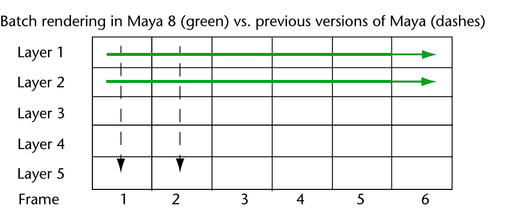Batch and command-line rendering interacts with render layers. Read this section to learn how they work together.
How frames are rendered with render layers on the command-line
When command-line rendering in previous versions of Maya, each render layer of a frame was rendered before moving on to the next frame.
In order to properly support the use of different renderers with different layers in Maya 8, rendering from the command line (render) renders all frames of a particular layer before moving on to the next layer, as seen in the following diagram.

Previous render behavior is shown by the dashed arrows; current render behavior is show with the green arrows. Layers are rendered in the order they appear in the layer manager.
This may have an impact on dispatchers and other render managers because scripts that are triggered by completion of a particular frame won’t be triggered until the last layer is being rendered.
To render all layers in the command-line renderer
render -r file <filename>
The batch renderer will use the specified renderers in the file per-layer to render the scene.
Additionally, the -rl flag specifies which layer to render.
For example, Render -r file -rl layer1 <filename> renders layer1 with the renderer specified in layer1; Render -r sw -rl layer1 <filename> renders layer1 with the software renderer, no matter what renderer is specified in the file.
The default renderer is the Maya software renderer.
When no renderer option is specified when using the render command, Maya uses a renderer called default. When Maya is installed, the software renderer specification is copied to default. If you want to change the default renderer (for example, to use the file renderer, which renders the scene based on the renderer specified in each render layer), copy: